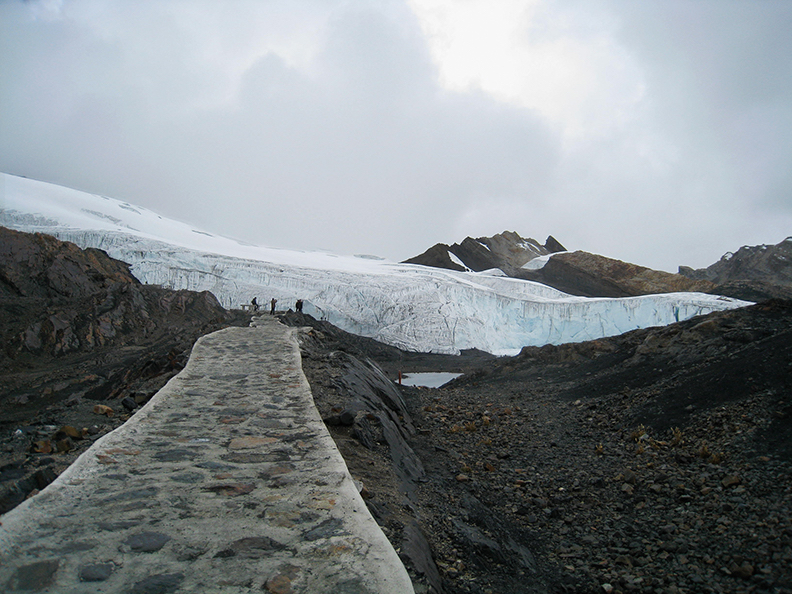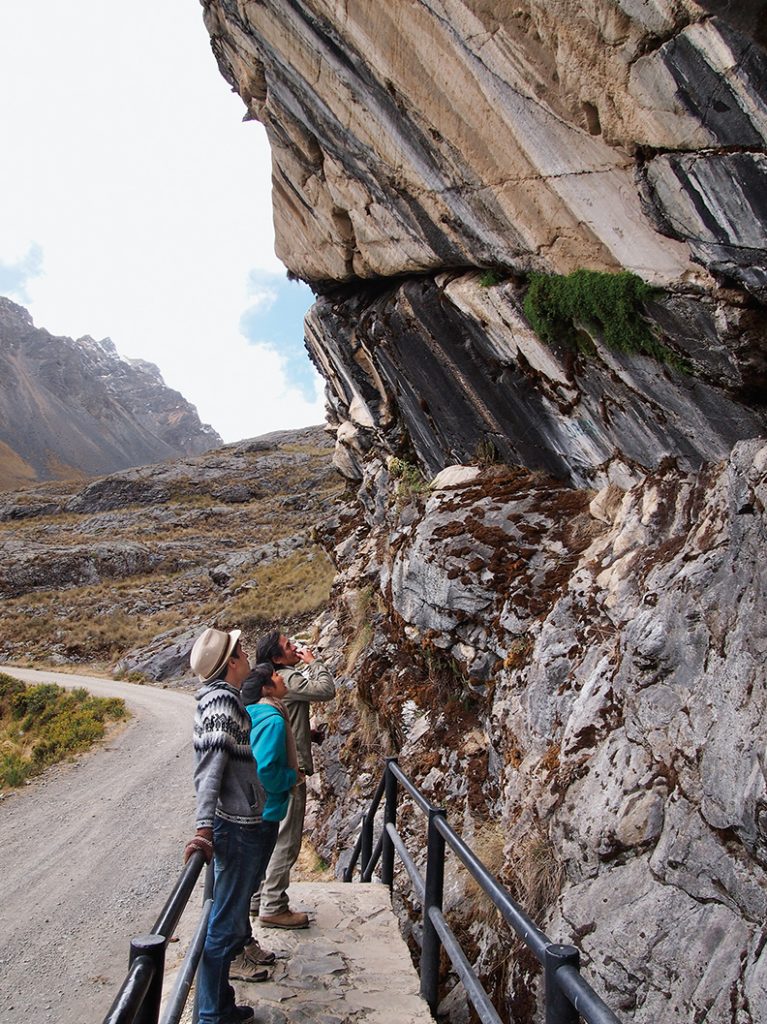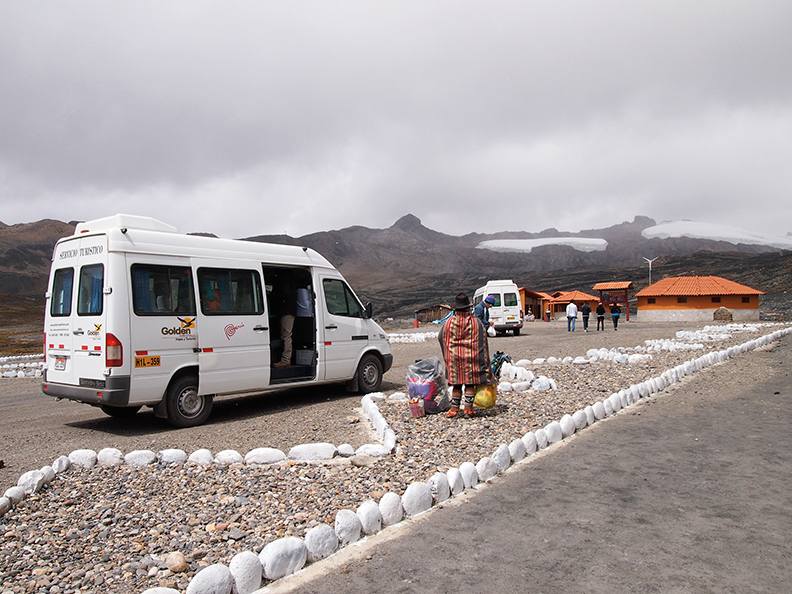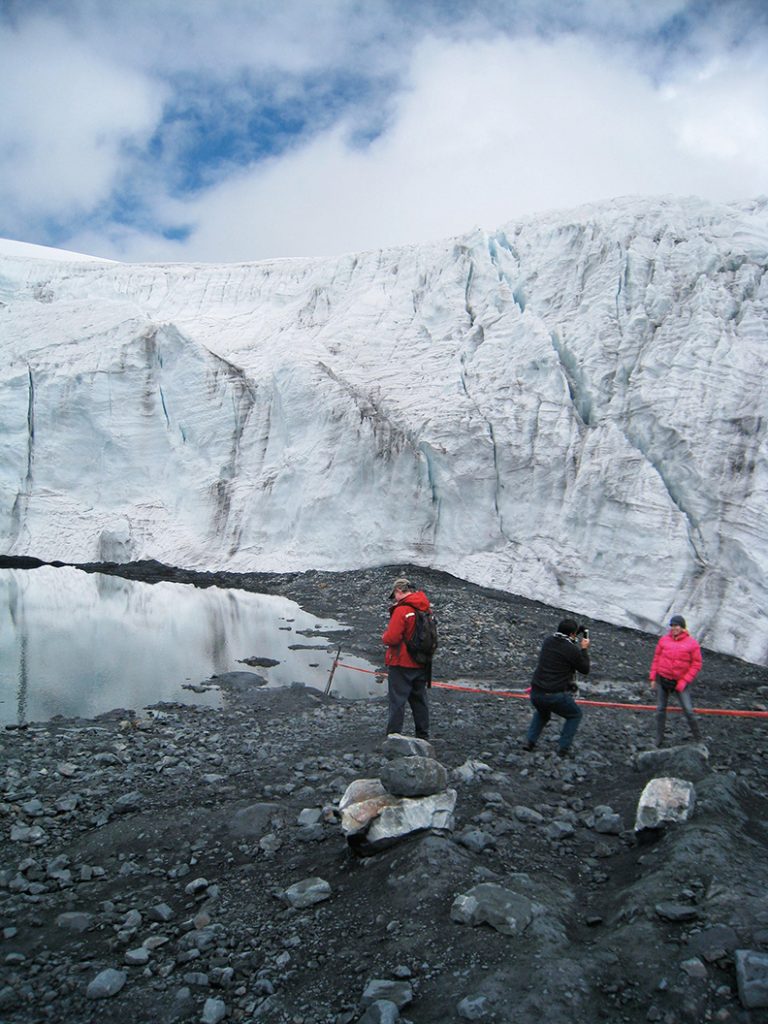BY MOLLY H. POLK

A sure way to put an end to a lively conversation in any social setting is to ask me about my work. The conversation goes something like this:
“You’re a geographer. What do you do, exactly?”
“I teach at UT Austin in the Department of Geography and the Environment, and my research is on the effects of climate change in Peru—how glacier recession impacts mountains and nearby communities.”
“Climate change is affecting people down there?”
“Yes, ecosystems are already seeing the effects of climate change and people are changing the way they live because of it.”
At that point, a worried look comes over the person’s face and they respond with a comment like, “Huh, that’s too bad,” and murmur something about needing a drink refill or spotting a long-lost friend on the other side of the room.
The realization that climate change is not only happening, but also having an impact on ecosystems and society, is more than most people want to face in a social situation. Understanding the psychology behind this reaction is beyond my expertise, but I suspect that, in that moment, climate change shifts from being abstract and in the distant future to being tangible and present, with consequences for real people.

Interactions with undergraduate students can follow a similar path. When teaching about climate change and its impacts, I find that discussions with students can lead to pessimism and paralysis. My challenge—and duty, arguably—is to nurture strategic thinking and to encourage creative problem solving. Whenever possible in the classroom, I share real-world examples of positive outcomes to foster the forward-thinking attitudes that are necessary to address climate change and promote sustainability. Positive outcomes can include possible future ways of living that are ingenious adjustments to changing and novel conditions. In this article, I describe one of those adjustments, better known in the scientific literature as adaptation.
According to the Intergovernmental Panel on Climate Change, adaptation is the process of adjustment to future climate and its effects. It is based on the notion that humans are inclined to moderate or avoid harm and exploit beneficial opportunities using new or different strategies (Field and Barros 2014). In July 2014, I observed an adaptation to climate change in Peru that ties glacier recession together with ecotourism, economic development, and joint government-community sponsorship. Interested in the intersection of glacier recession and tourism, Professor Kenneth Young (also from the Department of Geography and the Environment) and I signed up for the Ruta del Cambio Climático, a climate change ecotour in Huascarán National Park.
Impacts of Melting Ice
Much of the Cordillera Blanca mountain range lies within the boundaries of Huascarán National Park, known for spectacular alpine scenery, high mountain peaks, and tropical glaciers. Peru established the park in 1975, and it later became a UNESCO Biosphere Reserve and World Heritage Site. The area attracts Peruvians and foreign travelers alike, who concentrate their activities in the city of Huaraz, in the surrounding valley, known as the Callejón de Huaylas, and up on the mountains in the park. There are many pursuits available: trekking, hiking, rafting, rock climbing, alpine climbing, birding, visiting archaeological ruins, and mountain biking, among others. Tourism is a major economic driver in the region, second only to mining.
Two recent articles in the New York Times (Casey 2017, 2018) drew attention to glacier retreat in the park and to the environmental and social impacts associated with ice loss. As glaciers melt, water resources become a primary concern because less meltwater is available for human use and consumption, especially during the dry season. Declines in water quantity are accompanied by decreasing water quality and increasing variability of water availability throughout the year. As a result, livelihoods that traditionally relied on water supply, such as smallholder agriculture, pastoralism, agroforestry, and tourism, are at risk. Characteristics of the water supply are shifting and, simultaneously, local and regional demands for water are increasing, thus posing serious problems that mandate adaptations to novel conditions.
Researchers working in the area have documented adaptations to climate change that largely center on seeking out new economic opportunities. Providing tourist services (guiding, cooking, shepherding pack animals) constitutes a portion of some household livelihoods, especially for those located near the busier destinations in the park. Through surveys in two communities adjacent to the park, Jeff Bury and others (2011) linked the negative consequences of glacier recession on tourism to households. Glacier recession and decreasing tourism are occurring concurrently and, although no one has yet found a direct connection, it’s possible that the perception of ice loss and a degraded scenic landscape are deterrents to the eco-conscious tourist. In addition, popular climbing routes are now more hazardous because ice falls and avalanches are more common. These threats to tourism could reduce household incomes. David Wrathall and others (2014) have shown that glacier recession and associated increases in water resource stress are linked to household income diversification. Family members migrate to coastal cities in search of stable income; consequently, households are becoming more reliant on remittances.

The Climate Change Tour
The Ruta del Cambio Climático was first offered in June 2014, and Professor Young and I participated only one month after its inception. The ruta received press coverage in major newspapers, with marketing efforts directed toward Peruvians (Staff 2013; El Comercio 2014). Our tour began shortly before 8:00 a.m. in Huaraz in a 4×4 van full of Peruvian tourists, mostly from Lima. The day would take us from 3,000 meters above sea level (masl) in Huaraz, south and up in elevation through the Callejón de Huaylas to the village of Cátac, and finally to the Pastoruri glacier at over 5,000 masl. Our first stop out of Huaraz was at the Plaza de Armas in the village of Cátac to see the centerpiece of the modernized plaza, a sculpture of the endemic and iconic bromeliad, Puya raimondii. The second stop was at the park gate to register with park guards and pay entrance fees. Once inside the park, we stopped at the Bofedales de Pumapampa, where we hiked a short distance to see rainbow-colored thermal springs, unique high-altitude wetlands, and a population of Puya raimondii. We continued up the valley, arriving finally at our destination, the Pastoruri glacier.

Pastoruri captivates the imaginations of Peruvians, especially Limeños, who have long visited the glacier to experience snow. Its relatively easy road access made it a popular destination for these coast-dwelling visitors, who sledded and skied on the glacier. At the same time, the Comunidad Campesina de Cátac benefited economically through concession sales at the Pastoruri parking lot and in stores and restaurants in the village proper. High traffic on the glacier’s surface, combined with glacier recession, prompted park officials to close the area to recreation in 2007, around the time that the glacier cleaved into two smaller glaciers. Ice loss continues: from 2008 to 2016, the lowest margin of the ice retreated upslope over 100 meters (Silverio and Jaquet 2017). The ending of public access and recreation on the Pastoruri severely curtailed tourist-driven economic activity, and the Comunidad Campesina de Cátac felt those effects (Bury et al. 2011).
The objective of the Ruta del Cambio Climático is to offer an ecotourism adventure that highlights the effects of climate change through an immersive experience. Driving up the 2,000-meter elevation gradient provides for direct observations of climate change impacts supported by knowledgeable guides. During the stop at the Bofedales de Pumapampa, for example, visitors learn about the origins of these high-elevation wetlands and their recent transformations. My own work has shown that bofedales are shrinking in size and undergoing fragmentation, spatial transformations that are likely related to shifts in hydrology. As ice is lost, less meltwater flows into streams and rivers. In some park valleys, water is becoming more acidic because ice loss newly exposes bedrock that is then weathered, releasing acidic mineral compounds into streams. Signs of these water-related changes are evident at the Bofedales de Pumapampa. Midway up the valley, pictographs decorating the roadside cliffs remind visitors that humans have a long history in the area and are resilient.
At Pastoruri, ice loss is explained by repeat historical photography on signage. Unsorted till, small moraines, and rock scouring dot the landscape, reminders of earlier glacier erosion and deposition. Keen observers will notice pioneering plant species. Following glacier retreat, plants colonize newly revealed substrates in a climate change–induced process of ecological succession that Professor Young and I published about in 2017 (Young et al. 2017).
In essence, the Ruta del Cambio Climático reframes what was previously a destination for snow and ice recreation as a public educational opportunity. The program is the result of a collaboration among several government agencies and the local community, including Servicio Nacional de Áreas Naturales Protegidas por el Estado (SERNANP), Ministerio de Turismo, Municipalidad Distrital de Cátac, and Comunidad Campesina de Cátac (El Comercio 2014). Today, there are several operators that take visitors on the Ruta del Cambio Climático, but in 2014, the primary operator was Transporte Turístico Alpamayo. They specialize in adventure tours: daily excursions to nearby archaeological and ecological attractions, as well as overnight camping and trekking in the park, mountain bike rentals, and guided horseback rides and rock climbing. Transporte Turístico Alpamayo provided the transportation and guide services; the Ruta del Cambio Climático was a logical addition to their preexisting portfolio.

Relative to a visit to Pastoruri in 2011, there were many new and enhanced features: interpretive signage and maps, an expanded parking lot, improved restroom facilities, stalls for vendors, and a horse stable. The sidewalk from the parking lot up to the glacier and its small lakes (a distance of about 1 km) had been improved using concrete and rocks. Those who suffered from the altitude could pay a fee to ride up on horseback with arrieros from Comunidad Campesina de Cátac. Having spent the previous three weeks doing fieldwork in Huascarán National Park, Dr. Young and I were well acclimated and easily walked the distance to the ice. As we approached the glacier, our fellow travelers were celebratory and jubilant, posing for photographs and carefully styled selfies for Instagram and Facebook.

Ecotourism as Adaptation
The joint government-community sponsored program to rebrand Pastoruri as the Ruta del Cambio Climático is a positive outcome on several fronts. As intended, it educates Peruvians and foreigners about the impacts of climate change through an immersive daylong guided tour. It encourages people to visit the park and view the high mountain landscapes through the lens of climate change. The program restores economic opportunities for local residents and business owners, although admittedly the volume of visitors may not be what it was during the pre-2007 era. Tourists spend money along the way from Lima to Huaraz to Cátac and into the park, providing revenue to bus companies, hotels, restaurants, guides, drivers, concessionaires, the park, tour companies, and others.
The consequences of climate change and glacier recession in the Peruvian Andes are serious in terms of water resources, but there are examples of innovation and ingenuity that are adaptive strategies. The Ruta del Cambio Climático represents one way forward that capitalizes on new circumstances to attain economic and educational goals. It is an example of a jointly planned program that seizes a new opportunity through adaptation.
Molly H. Polk, PhD, is the associate director of Sustainability Studies and a lecturer in the Department of Geography and the Environment, The University of Texas at Austin. She is a geographer who specializes in land change science in the tropical mountains of Latin America.
References
Bury, J., B.G. Mark, J.M. McKenzie, A. French, M. Baraer, K. I. Huh, M. Zapata Luyo, and R. Gómez López. 2011. Glacier recession and human vulnerability in the Yanamarey watershed of the Cordillera Blanca, Peru. Climatic Change 105:179–206.
Casey, N. 2017. In Peru’s Deserts, Melting Glaciers Are a Godsend (Until They’re Gone). The New York Times 26 November (last accessed 21 April 2018).
———. 2018. A Lifetime in Peru’s Glaciers, Slowly Melting Away. The New York Times 26 January (last accessed 21 April 2018).
El Comercio. 2014. El Pastoruri es hoy la ruta del cambio climático. El Comercio 8 July (last accessed 27 April 2018).
Field, C.B., and V.R. Barros, eds. 2014. Climate Change 2014: Impacts, Adaptation, and Vulnerability. Part A: Global and Sectoral Aspects. Contribution of Working Group II to the Fifth Assessment Report of the Intergovernmental Panel on Climate Change. Cambridge, UK, and New York: Cambridge University Press.
Silverio, W., and J.-M. Jaquet. 2017. Evaluating glacier fluctuations in Cordillera Blanca (Peru) by remote sensing between 1987 and 2016 in the context of ENSO. Archives des Sciences 69:145–162.
Staff. 2013. Crean “La ruta del cambio climático” para atraer nuevos turistas al nevado Pastoruri. Gestión 10 November (last accessed 30 April 2018).
Wrathall, D.J., J. Bury, M. Carey, B. Mark, J. McKenzie, K.R. Young, M. Baraer, A. French, and C. Rampini. 2014. Migration amidst climate rigidity traps: Resource politics and social-ecological possibilism in Honduras and Peru. Annals of the Association of American Geographers 104:292–304.
Young, K.R., A.G. Ponette-González, M.H. Polk, and J.K. Lipton. 2017. Snowlines and treelines in the Tropical Andes. Annals of the American Association of Geographers 107:429–440.
